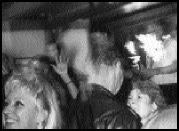BLIND CHICKENS AND SOCIAL ANIMALS: CREATING SPACES FOR AFGHAN WOMEN’S NARRATIVES UNDER THE TALIBAN by Anna M. Pont (Mercy Corps, $15)
A SLIM study of rural women in Taliban-ruled Afghanistan, Blind Chickens and Social Animals aims to let Afghan women tell their own stories in their own words, without portraying them as helpless victims or unthinking pawns of male oppressors. Writer Anna Pont, an anthropologist and community development worker with nonprofit aid group Mercy Corps, wants to create a nonjudgmental narrative of Afghan women’s lives. The problem with her premise is that in a country where adultery is grounds for execution and leaving one’s family compound can result in ostracism or death, the usual rules of cultural respect and moral relativism simply don’t, and can’t, apply.
Still, you want to believe Pont and the workers of Mercy Corps, who labored exhaustively under trying conditions to collect the 218 interviews that form the basis for this study. You want to trust her when she claims that most rural Afghan women are content with their lots in life, that the Taliban are hardly worse than any other regime Afghanis have had to endure, and that wearing the burqa is, for many women, a choice, not a symbol of oppression.
You want to believe this because these are women’s voices, unfiltered by Western norms, and because intuitively you know Pont’s critique of the West is right. We do “homogenize” and vilify unfamiliar cultures and religious traditions. We tend to see women—particularly Middle Eastern women—as helpless victims of circumstance and fate, required to wear the veil or don the chador by their oppressive male leaders and backward religious beliefs. But the fact remains that even the vast cultural gulf that separates the East from the West doesn’t account for a regime that forced girls to quit school, restricted them from leaving their homes, decreed that women who were raped could be forced to marry or be killed, and required women to wear the all- enveloping burqa. That’s not, as Pont insists, a cultural disagreement—it’s gender terrorism. (Pont’s assertion that “men are also being oppressed,” because they must wear tunics and turbans and work harder than women, is a particularly jagged pill.)
Pont argues that the goal of the Taliban was not to ruin the country but to purify it, however heinous their means; and that, moreover, the Taliban were only the latest incarnation of an already conservative system in which women have long had to endure restrictions on their mobility and visibility. Because men and women can’t be trusted to control their sexual desires, Pont says, rural Afghan norms have always required that they be kept apart and that women’s bodies be concealed. (This could be one reason the average age at marriage in Afghanistan is 15; many women interviewed for this study were mothers once or twice over before they were out of puberty.) Men have always decided when, and whether, women can leave their homes and whether they receive health care, Pont adds; the Taliban just took it a step further, by threatening, for example, to cut off the hands of anyone who sent their daughters to school. Pont is quick to note that this particular threat was rarely carried out, adding that women “are keen to point out” that “they themselves are in part to blame” for the closure of rural girls’ schools, because they did not understand the value of education.
WHAT PONT DOES not note is that many women were, judging from recent media coverage of the situation in Afghanistan, deeply afraid to talk honestly about their position in society. As Taliban strongholds have fallen across the country, photographs of women joyfully shedding their heavy burqas and interviews with women who say they have been terrified to speak out about their oppression have filled Western newspapers and perhaps given those of us in the United States a clearer picture of what Taliban rule meant for the women under its control.
Of course, as Pont would undoubtedly point out, Newsweek and CNN are imperfect sources. They view Afghan women through American eyes, which can’t perceive every nuance of that country’s complex social structure and rich cultural history. Indeed, if Pont’s study has any lasting value, it will be that it offers one thing CNN cannot: a revealing look into a world that has, for the past seven years, been largely concealed from the West.







